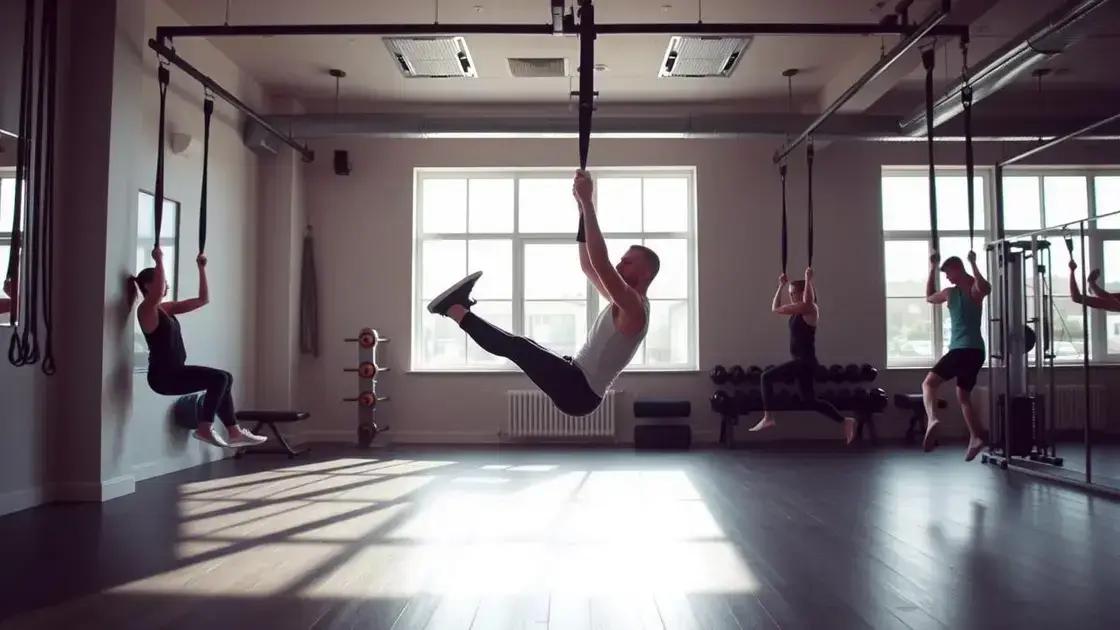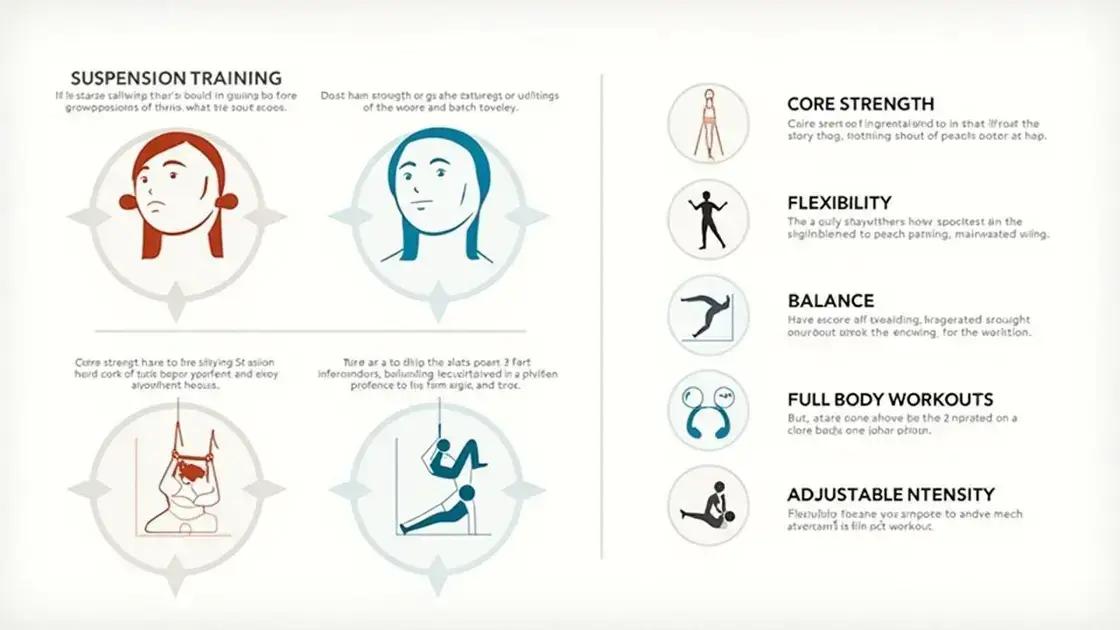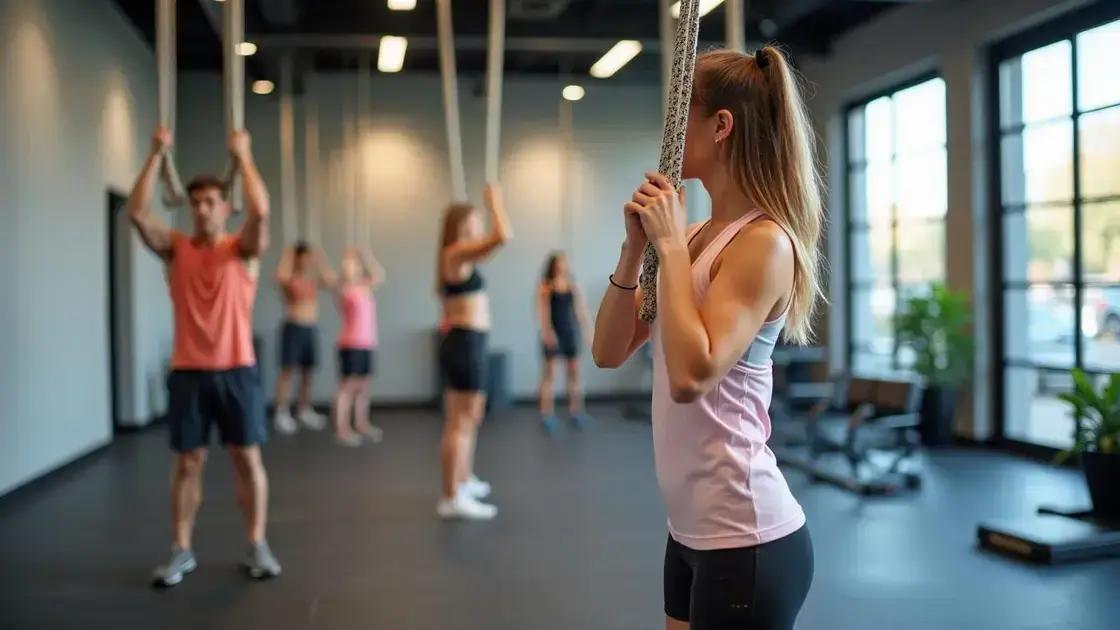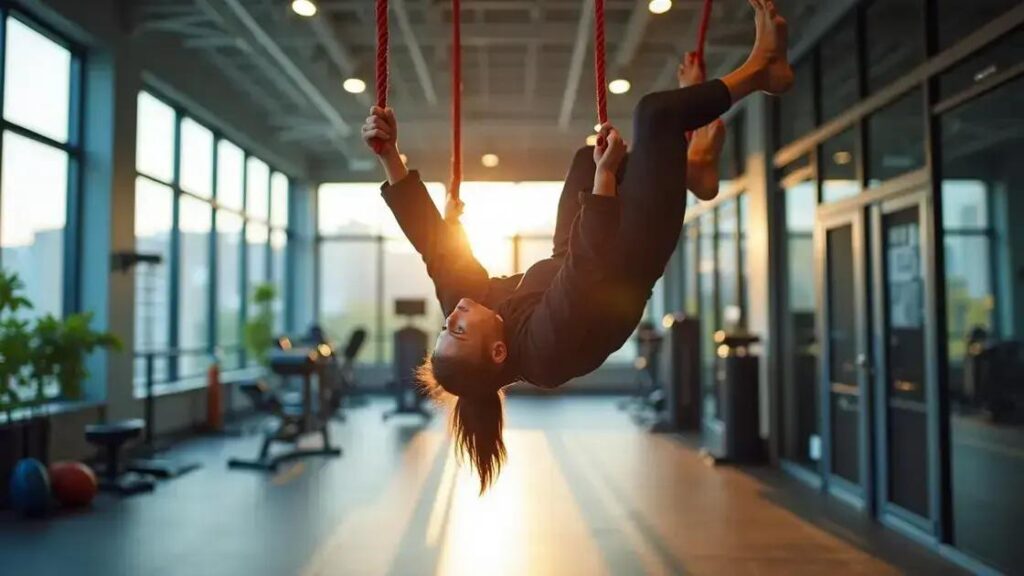Suspension training is an effective workout method that leverages body weight for resistance, providing full-body strength improvement, enhanced core stability, flexibility, and balance. By incorporating various exercises with a suspension trainer, individuals of all fitness levels can achieve their fitness goals through customizable and engaging workouts.
Are you ready to transform your workouts? Suspension training is an innovative approach that provides a full-body strength workout using your own body weight. This versatile training method not only builds muscle but also improves your balance and flexibility. In this article, we will delve into what suspension training is, its numerous benefits, effective exercises, and expert tips to help you get started.
Introduction to Suspension Training

Suspension training is a dynamic workout system that uses a suspension trainer to leverage body weight for resistance training. This method allows you to adjust the intensity of your workout based on your body position, which is perfect for individuals at any fitness level. With suspension training, you engage multiple muscle groups simultaneously, making it a time-efficient and effective approach to building strength.
How Suspension Training Works
The key principle behind suspension training is instability. By strapping yourself into a system of straps, you challenge your core stabilizers as you perform various exercises. This not only strengthens the targeted muscles but also improves balance, coordination, and flexibility. Exercises can range from push-ups to rows, and many can be modified to suit your skill level.
The Versatility of Suspension Training
One of the most appealing aspects of suspension training is its versatility. You can perform a wide variety of exercises, making it suitable for both cardio and strength workouts. Additionally, suspension trainers are portable and can be used almost anywhere—at home, in the park, or at the gym—allowing for flexibility in your fitness routine.
Getting Started with Suspension Training
To begin, you’ll need a suspension trainer. Popular options include the TRX system and other similar devices. Start with basic exercises to master the fundamentals and focus on form rather than the number of reps. As you gain confidence and strength, you can gradually increase the complexity of your workouts.
Key Benefits of Suspension Training

Suspension training offers numerous benefits that make it an excellent choice for anyone looking to improve their fitness levels. Here are some key advantages:
Improves Core Strength
Since suspension training requires you to stabilize your body during workouts, it engages your core muscles effectively. This leads to enhanced core strength, which is vital for good posture, balance, and overall functional fitness.
Increases Flexibility
Various suspension exercises promote flexibility by allowing you to move through a full range of motion. This helps in reducing tightness and enhancing flexibility in different muscle groups, especially the hips, shoulders, and back.
Boosts Balance and Coordination
Training with a suspension trainer challenges your balance and coordination. As you perform different movements, your body learns to stabilize itself, which can improve your performance in other physical activities and sports.
Provides a Full-Body Workout
One of the main benefits of suspension training is the ability to work multiple muscle groups at once. Many exercises can target the upper body, lower body, and core together, making your workout time-efficient and effective.
Customizable Intensity Levels
With suspension training, you have the power to adjust the intensity of your workouts easily. By changing your body angle or position, you can either simplify or challenge the exercise, making it suitable for all fitness levels.
Effective Full-Body Suspension Exercises

Suspension training involves a variety of effective full-body exercises that can build strength and improve overall fitness. Here are some of the most effective exercises you can practice:
1. Suspended Push-Ups
This exercise targets your chest, shoulders, and triceps while also engaging your core. Begin in a plank position with your feet in the straps. Lower your chest towards the ground and push back up while maintaining a straight body line.
2. Rows
The row exercise focuses primarily on your back and biceps. Stand facing the anchor point, grab the handles, and lean back. Pull your body towards the handles and squeeze your shoulder blades together. Keep your core tight throughout the movement.
3. Squats
Suspended squats strengthen your legs and core. Hold the handles and lean back while performing a squat. Make sure to keep your knees behind your toes as you lower down, ensuring proper form.
4. Plank to Pikes
This challenging movement engages the core, shoulders, and hips. Start in a plank position with your feet in the straps. Lift your hips up towards the ceiling, forming a V-shape with your body, then return back to the plank position.
5. Chest Fly
This exercise targets the chest muscles while also working the shoulders and core. Stand with your back to the anchor point, hold the handles wide apart, and slowly bring your arms together in front of you, then open them back out to the sides.
Tips for Getting Started with Suspension Training

Getting started with suspension training can be both exciting and challenging. Here are some helpful tips to ensure a smooth introduction:
1. Choose the Right Suspension Trainer
There are many brands and types of suspension trainers available on the market. Look for one that is durable, has adjustable straps, and includes a variety of exercise options to help you get started.
2. Learn Proper Form
Before diving into exercises, take time to learn the correct form. This is vital for avoiding injuries and maximizing your workout results. There are many online tutorials and class options available that can guide you.
3. Start Slow and Gradually Increase Intensity
Begin with simpler exercises to build your strength and confidence. As you get comfortable, you can gradually increase the intensity of your workouts by incorporating more challenging movements.
4. Incorporate a Warm-Up and Cool-Down
Just like any workout routine, warming up before suspension training and cooling down after is essential. This helps to prevent injuries and aids in muscle recovery.
5. Set Realistic Goals
Establish achievable fitness goals that keep you motivated. Whether it’s performing a certain number of repetitions or mastering a new exercise, tracking your progress can help you stay focused.
6. Mix It Up
To avoid boredom and plateaus, vary your suspension training routine by mixing in different exercises and adjusting your angle. This keeps your workouts fresh and engaging.
Harnessing the Power of Suspension Training for Fitness
Suspension training offers a versatile and effective method for achieving full-body strength. By focusing on core stability, flexibility, and multi-muscle engagement, it caters to individuals of all fitness levels. With the right exercises, a clear set of goals, and a commitment to learning proper form, anyone can incorporate suspension training into their fitness routine.
As you explore this training method, remember to start slow, gradually build up your intensity, and keep your workouts engaging by mixing different exercises. With consistency and determination, you’ll experience the benefits of improved strength, balance, and muscle tone.
Suspension training can be a game-changer in your fitness journey, helping you unlock new potential and achieve your goals.
FAQ – Frequently Asked Questions about Suspension Training
What is suspension training?
Suspension training is a type of workout that uses a suspension trainer to leverage body weight for resistance exercises, improving strength, balance, and flexibility.
What are the key benefits of suspension training?
Key benefits include improved core strength, increased flexibility, enhanced balance and coordination, full-body workouts, and customizable intensity levels.
Can anyone do suspension training?
Yes, suspension training is suitable for individuals of all fitness levels. Beginners can start with basic exercises and gradually increase the intensity as they build strength.
What equipment do I need for suspension training?
You need a suspension trainer, such as a TRX system, which can be anchored to a door, ceiling, or outdoor support for various exercises.
How should I start with suspension training?
Begin by learning proper form for basic exercises, start slow to build confidence, and gradually incorporate more challenging movements as you improve.
How often should I do suspension training?
It’s recommended to include suspension training in your workout routine 2-3 times per week, allowing time for recovery between sessions.












